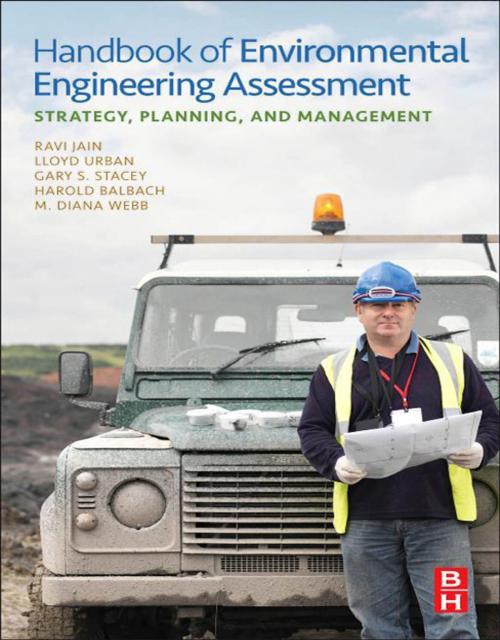Handbook of Environmental Engineering Assessment
Strategy, Planning, and Management
Nonfiction, Reference & Language, Law, Environmental, Science & Nature, Science, Biological Sciences, Environmental Science, Nature| Author: | Ravi Jain, Lloyd Urban, Harold Balbach, M. Diana Webb | ISBN: | 9780123884459 |
| Publisher: | Elsevier Science | Publication: | June 21, 2012 |
| Imprint: | Butterworth-Heinemann | Language: | English |
| Author: | Ravi Jain, Lloyd Urban, Harold Balbach, M. Diana Webb |
| ISBN: | 9780123884459 |
| Publisher: | Elsevier Science |
| Publication: | June 21, 2012 |
| Imprint: | Butterworth-Heinemann |
| Language: | English |
This is one of the most comprehensive books on complex subjects of environmental engineering assessment and planning. Addressing these issues requires an understanding of technical, economic, and policy perspectives; based upon extensive research and practical experience of the authors, these perspectives are thoughtfully and clearly presented.
Covered in this book are subjects related to environmental engineering and planning which include environmental laws and regulations, international perspectives on environmental analysis engineering and planning, economic and social impact analysis, public participation, and energy and environmental implications of major public works and private projects. Contemporary issues ranging from climate change to ecorisk and sustainability are covered in a special section as well.
Under Contemporary Challenges are environmental issues that have received considerable public support and concern; they include: climate change, acid rain, deforestation, endangered species, biodiversity, ecorisk, cultural resources, and sustainability. For most of these issues, there are scientific agreements and disagreements; there are many uncertainties, thus views differ widely. These topics are discussed in considerable detail. Notwithstanding uncertainties and differing views on such topics, all of this information is put in a policy context such that progress towards addressing these contemporary challenges can be made while consensus on the nature and extent of the problem and resultant solutions are being developed.
The book provides considerable information about many timeless issues. These issues range from resources needed for sustaining the quality of life on the planet: air resources to natural resources. Specifically covered are: air, water, land, ecology, sound/noise, human aspects, economics, and resources. For each of these areas, some of the key elements are described so that one can effectively manage complex environmental engineering and planning requirements. Each of the elements are clearly defined and other information, such as how human activities affect the element, source of affects, variable to be measured, how such variables can be measured, data sources, and evaluation and interpretation of data, etc. are provided. Material presented provides a rich source of information so the reader can efficiently and effectively use it to make meaningful environmental engineering, planning, and management decisions.
- Help with every aspect of analyzing the environmental implications of a project
- Complete coverage of current approaches, practices, procedures, documentations, regulations, and issues related to environmental engineering and planning
- Step-by-step directions for preparing environmental impact analysis, and environmental reports
- Valuable expert advice on international perspectives, public participation, social and environmental impacts
- A comprehensive write-up on contemporary issues ranging from climate change to sustainability
- A comprehensive description and analysis of timeless issues ranging from air resources to natural resources
This is one of the most comprehensive books on complex subjects of environmental engineering assessment and planning. Addressing these issues requires an understanding of technical, economic, and policy perspectives; based upon extensive research and practical experience of the authors, these perspectives are thoughtfully and clearly presented.
Covered in this book are subjects related to environmental engineering and planning which include environmental laws and regulations, international perspectives on environmental analysis engineering and planning, economic and social impact analysis, public participation, and energy and environmental implications of major public works and private projects. Contemporary issues ranging from climate change to ecorisk and sustainability are covered in a special section as well.
Under Contemporary Challenges are environmental issues that have received considerable public support and concern; they include: climate change, acid rain, deforestation, endangered species, biodiversity, ecorisk, cultural resources, and sustainability. For most of these issues, there are scientific agreements and disagreements; there are many uncertainties, thus views differ widely. These topics are discussed in considerable detail. Notwithstanding uncertainties and differing views on such topics, all of this information is put in a policy context such that progress towards addressing these contemporary challenges can be made while consensus on the nature and extent of the problem and resultant solutions are being developed.
The book provides considerable information about many timeless issues. These issues range from resources needed for sustaining the quality of life on the planet: air resources to natural resources. Specifically covered are: air, water, land, ecology, sound/noise, human aspects, economics, and resources. For each of these areas, some of the key elements are described so that one can effectively manage complex environmental engineering and planning requirements. Each of the elements are clearly defined and other information, such as how human activities affect the element, source of affects, variable to be measured, how such variables can be measured, data sources, and evaluation and interpretation of data, etc. are provided. Material presented provides a rich source of information so the reader can efficiently and effectively use it to make meaningful environmental engineering, planning, and management decisions.
- Help with every aspect of analyzing the environmental implications of a project
- Complete coverage of current approaches, practices, procedures, documentations, regulations, and issues related to environmental engineering and planning
- Step-by-step directions for preparing environmental impact analysis, and environmental reports
- Valuable expert advice on international perspectives, public participation, social and environmental impacts
- A comprehensive write-up on contemporary issues ranging from climate change to sustainability
- A comprehensive description and analysis of timeless issues ranging from air resources to natural resources















